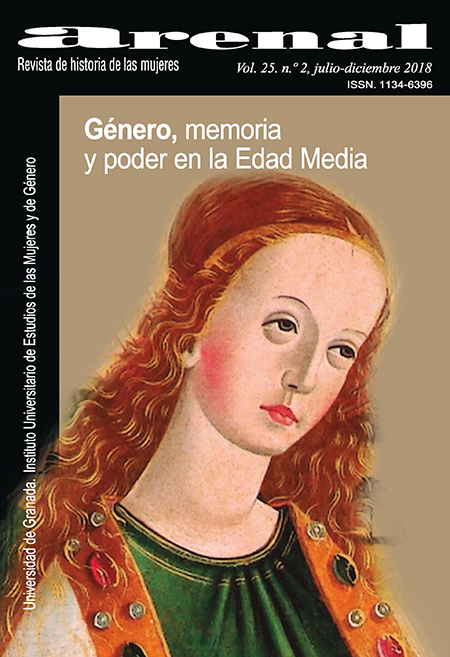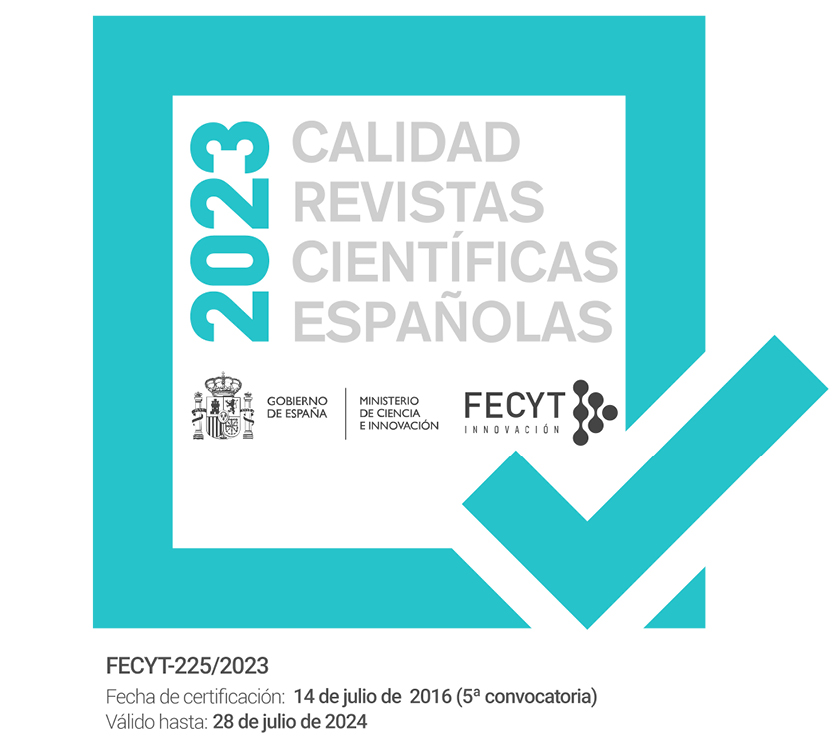Manly Minds in Female Bodies: Women’s Power through Coins and Seals
DOI:
https://doi.org/10.30827/arenal.v25i2.7640Keywords:
Gender, Coins, Seals, Art, Queen Urraca of León-Castilla, Empress Matilda of England, Duchess Bertha of Lorraine, Twelfth centuryAbstract
This article investigates coins and seals as instruments that reflect the desire for self-representation and remembrance of ruling women. An analysis of these small but important objects connected to Queen Urraca of León-Castilla (r. 1109-1126), Empress Matilda of England (r. 1135-1154), and Duchess Bertha of Lorraine (r. 1176-1194/95), will show that they each constructed the visual image of their rule by employing a masculine iconography to craft their identities. Originating directly from the power these lordly women, their coins and seals convey how they represented themselves and consequently how they wished to be recognized and recollected. As such, these objects were part of a wider medieval memorial culture to which the creation of artefacts and architecture was crucial.
Downloads
References
ANDERSON, Carolyn: “Narrating Matilda, “Lady of the English,” in the “Historia Novella”, the “Gesta Stephani”, and Wace’s “Roman de Rou”: The Desire for Land and Order”. Clio. A journal of literature, history and the philosophy of history 29-1 (1999), 47-67.
BEDOS-REZAK, Brigitte Miriam: “Women, seals and power in medieval France, 1150-1350”. In ERLER, M. and KOWALESKI, M. (eds.): Women and power in the Middle Ages. Athens, Ga., and London, The University of Georgia Press, 1988, pp. 61-82.
— “In Search of a Semiotic Paradigm: The Matter of Sealing in Medieval Thought and Praxis (1050-
”. In ADAMS, Noël, CHERRY, John and ROBINSON, James (eds.): Good Impressions: Image and Authority in Medieval Seals. London: The British Museum, 2008, pp. 1-7.
— When Ego Was Imago: Signs of Identity in the Middle Ages. Leiden, Brill, 2011. BIJSTERVELD, Arnoud-Jan A.: “The medieval gift as agent of social bonding and political power: A comparative approach”. In COHEN, Esther and JONG, DE Mayke B. (eds.): Medieval trans-formations: Texts, power and gifts in context. Leiden, Brill, 2001, pp. 123-156.
BROOKE, George Cyril: A catalogue of English coins in the British Museum: The Norman Kings. London, British Museum, 1916.
CARLESS DAVID, Henry William, WHITWELL, Robert Jowitt, and JOHNSON, Charles (eds.): Regesta regum anglo-normannorum, 1066-1154, 3 vols. Oxford, Clarendon Press, 1913.
CAVERO, Gregoria: “Sancha Raimúndez: An infanta in the exercise of her power”. Imago Temporis. Medium Aevum 7 (2013) 271-297.
CAYROL BERNARDO, Laura: “De infantas, domnae y Deo votae. Algunas reflexiones en torno al infantado y sus senoras”. SVMMA 3 (2014) 5-23.
CHIBNALL, Marjorie: “The Empress Matilda and Bec-Hellouin”. In BROWN, Reginald Allan (ed.): Proceedings of the Battle Conference 1987. Woodbridge, Boydell & Brewer, 1988, pp. 35-48.
CHIBNALL, Marjorie: The Empress Matilda: Queen Consort, Queen Mother and Lady of the English. Oxford, Blackwell Publishers, 1999 [1991].
— “The Charters of the Empress Matilda”. In GARNET, George and HUDSON, John (eds.): Law and government in medieval England and Normandy: Essays in honor of Sir James Holt.
Cambridge, Cambridge University Press, 1994, pp. 276-298.
CRUSAFONT, Miguel, BALAGUER, Anna M. and GRIERSON, Philip (eds.): Medieval European coinage: With a catalogue of the coins in the Fitzwilliam Museum, Cambridge. 6: The Iberian Peninsula. Cambridge, Cambridge University Press, 2013.
DUVERNOY, Émile (1904): Le duc de Lorraine Mathieu Ier (1139-1176). Paris, Picard.
— “Catalogue des actes des ducs de Lorraine de 1176 à 1220.” Mémoire de la Société d’archéologie Lorraine 64 (1914), 121-306.
Florentii Wigorniensis monachi Chronicon ex chronicis: ab adventu Hengesti et Horsi in Britanniam usque ad annum M.C.XVII., 2 vols. London, Sumptibus Societatis, 1848-1849.
HENRIET, Patrick: “Infantes, Infantaticum. Remarques introductives”. e-Spania[En ligne], 5 | juin 2008, mis en ligne le 29 janvier 2014. URL: http://e-spania.revues.org/12593.
JASPERSE, Jitske: “A coin bearing testimony to Duchess Matilda as consors regni”. Haskins Society Journal 26 (2014), pp. 169-190.
— “To Have and to Hold: Coins and Seals as Evidence for Motherly Authority”. In FLEINER, Carey, and WOODACRE, Elena (eds.): Royal Mothers and Their Ruling Children: Wielding Political Authority from Antiquity to the Early Modern Era. Basingstoke, Palgrave Macmillan, 2015, pp. 83-104.
JOHNS, Susan M.: Noblewomen, aristocracy and power in the twelfth-century Anglo-Norman Realm. Manchester: Manchester University Press, 2003.
JORDAN, Erin L.: “Swords, seals and coins. Rulers and the instruments of authority in thirteenth- century Flanders and Hainaut”. In SOLWAY, Susan (ed.): Medieval coins and seals: Constructing identity, signifying power. Turnhout, Brepols, 2015, pp. 229-246.
KLÖSSEL-LUCKHARDT, Barbara: “Et sigillo illustris uxoris nostre – Weibliche Repräsentation in frühen Frauensiegeln des Welfenhauses”. In LEMBKE, Katja, LUCKHARDT, Jochen and STAMM, Rainer (eds.): Niederdeutsche Beiträge zur Kunstgeschichte, Neue Folge, Band 2, Petersberg, Michael Imhof Verlag, 2017, pp. 27-52.
LOPRETE, Kimberly A.: “Gendering viragos. Medieval perceptions of powerful women”. In MEEK, Catherine and LAWLESS, Catherine (eds.): Studies on medieval and early modern women 4: Victims or viragos? Dublin, Four Courts Press, 2005, pp. 17-38.
— “The gender of lordly women. The case of Adela of Blois”. In MEEK, Christine and LAWLESS, Catherine (eds.): Pawns or players? Studies on medieval and early modern women. Dublin, Four Courts Press, 2013, pp. 90-110.
MACK, R.P.: “Stephen and the Anarchy 1135-1154”. British Numismatic Journal 35 (1966), 38-112.
MARTIN, Therese: “The art of a reigning queen as dynastic propaganda in twelfth-century Spain”. Speculum 80-4 (2005), 1134-1171.
— Queen as king: Politics and architectural propaganda in twelfth-century Spain. Leiden, Brill, 2006.
MARTÍNEZ SOPENA, Pascual and RODRÍGUEZ, Ana: “Introducción”. In MARTÍNEZ SOPENA, Pascual and RODRÍGUEZ, Ana (eds.): La construcción medieval de la memoria regia. Valencia, Publicacions Universitat de València, 2011, pp. 11-20.
MONTER, William: “Gendered sovereignty: Numismatics and female monarchs in Europe, 1300- 1800”. Journal of Interdisciplinary History 41-4 (2011), 533-564.
NIELEN, Marie-Adélaïde: Corpus des sceaux français du Moyen âge 3. Tome III, Les sceaux des reines et des enfants de France. Paris, Service interministériel des Archives de France, 2011.
NIEUS, Jean-François: “Early Aristocratic Seals: An Anglo-Norman Success Story”. Anglo-Norman Studies 28 (2016), 97-123.
NOLAN, Kathleen: Queens in stone and silver: The creation of a visual imagery of queenship in Capetian France. New York, Palgrave Macmillan, 2009.
OEXLE, Otto Gerhard: “Memoria und Memorialbild”. In SCHMID, Karl and WOLLASCH, Joachim (eds.): Memoria. Der geschichtliche Zeugniswert des liturgischen Gedenkens. München, Fink, 1984, pp. 384-440.
PALLARÉS MÉNDEZ, María del Carmen and PORTELA SILVA, Ermelindo: La reina Urraca. Donostia, Nerea, 2006.
PAUL, Nicolas L.: To follow in their footsteps: The crusades and family memory in the high Middle Ages. Ithaca, Cornell University Press, 2012.
PFISTER, C.: “Documents sur le prieuré Notre-Dame de Nancy”. Annales de l’Est. Revue Trimestrielle 11 (1897), 77-176.
POULL, Georges: La maison ducale de Lorraine devenue la maison impériale et royale d’Autriche, de Hongrie et de Bohême. Nancy, Presses universitaires de Nancy, 1991.
ROMA VALDÉS, Antonio: “Notas sobre las acuñaciones medievales leonesas: primeros escritos conocidos y las emisiones de Doña Urraca”. OMNI 10-7 (2016), 56-73.
RUIZ ALBI, Irene: La Reina doña Urraca (1109-1126): Cancillería y colección diplomática. León, Centro de Estudios e investigación “San Isidoro”. Caja España de Inversiones y Archivo Histórico Diocesano, 2003.
SERRANO COLL, Marta: “Iconografía de género. Los sellos de las reinas de Aragón en la Edad Media (siglos XII-XVI)”. Emblemata 12 (2006), 15-52.
SOLWAY, Susan: “Introduction”. In SOLWAY, Susan (ed.): Medieval coins and seals: constructing identity, signifying power. Turnhout, Brepols, 2015, pp. 9-20.
STAHL, Alan M.: “Coinage in the name of medieval women”. In ROSENTHAL, Joel T. (ed.): Medieval women and the sources of medieval history. Athens, Ga., The University of Georgia Press, 1990, pp. 321-341.
STIELDORF, Andrea: “Die Siegel der Herrscherinnen. Siegelführung und Siegelbilder der deutschen Kaiserinnen und Königinnen”. Rheinische Vierteljahrsblätter 64 (2000), 1-44.
STUBBS, W. (ed.): Radulfi de Diceto Decani Lundoniensis Opera Historica (Rolls, Rerum Britannicarum Medii Aevi Scriptores 68), 2 vols. London, Longman, 1876.
TODESCA, James J.: What touches all: Coinage and monetary policy in Leon-Castile to 1230 (PhD diss.). Fordham University, New York, 1996.
VAISSE, Damien: “Les sceaux lorrains du XIIe siècle dans le fonds de l’abbaye de Clairvaux aux Archives de l’Aube”. Lotharingia 10 (2011), 179-199.
VAN HOUTS, Elisabeth: Memory and gender in medieval Europe 900-1200. Houndsmills, MacMillan Press LTD, 1999.
Websites
Chartes originales conservées en France (1121-1220), Traitement électronique des manuscrits et des archives, http://www.cn-telma.fr.
Medieval Memoria Online (MeMO), http://memo.hum.uu.nl/.
Numismatico digital, http://www.numismaticodigital.com/noticia/9243/subastas-nacionales/piezas-muy-interesantes-en-la-subasta-144-de-jesus-vico.html.
The British Museum Collection Online, http://www.britishmuseum.org/research/collection_online/search.aspx.
Downloads
Additional Files
Published
How to Cite
Issue
Section
License
Los/as autores/as que publican en esta revista están de acuerdo con los siguientes términos:
Los autores/as conservarán sus derechos de autor y garantizarán a la revista el derecho de primera publicación de su obra, el cuál estará simultáneamente sujeto a la Licencia de reconocimiento de Creative Commons 4.0 BY-NC-ND que permite a terceros compartir la obra siempre que se indique su autor y su primera publicación esta revista.
Los autores/as podrán adoptar otros acuerdos de licencia no exclusiva de distribución de la versión de la obra publicada (p. ej.: depositarla en un archivo telemático institucional o publicarla en un volumen monográfico) siempre que se indique la publicación inicial en esta revista.
Se permite y recomienda a los autores/as difundir su obra a través de Internet (p. ej.: en archivos telemáticos institucionales o en su página web) antes y durante el proceso de envío, lo cual puede producir intercambios interesantes y aumentar las citas de la obra publicada. (Véase El efecto del acceso abierto).


















